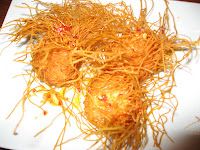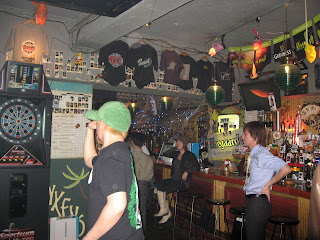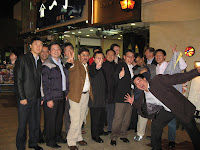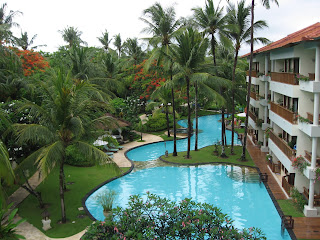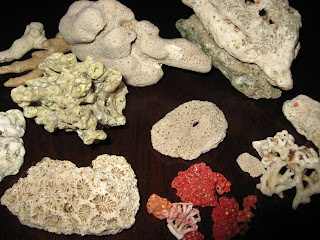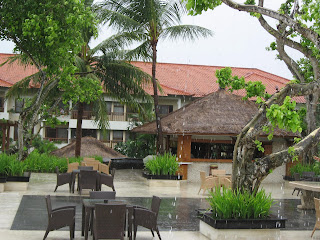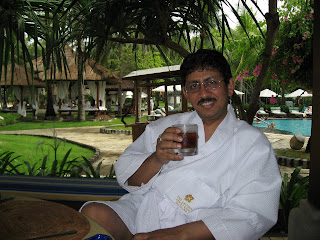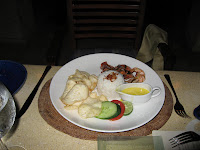We arrived in Bali late evening on a Malaysia Airlines flight from Kuala Lumpur. The Ngurah Rai international airport is located in Denpasar, on the southern tip of Bali and close to the major beach and resort destinations of Jimbaran, Kuta and Nusa Dua. This was the first time I had travelled by Malaysia Airlines, and I found the experience a good one on all counts: professionalism, service and in-flight food.
 The airport is not a glass and steel structure; you see wooden fixtures, intricate carvings, stone sculptures, etc. The entire process of getting a visa on arrival, immigration and customs took less than 30 mins. Our resort was in Nusa Dua, on the southern-most tip of Bali; this area has been developed relatively recently, relatively more secure, and home to some of the upscale resorts and hotels.
The airport is not a glass and steel structure; you see wooden fixtures, intricate carvings, stone sculptures, etc. The entire process of getting a visa on arrival, immigration and customs took less than 30 mins. Our resort was in Nusa Dua, on the southern-most tip of Bali; this area has been developed relatively recently, relatively more secure, and home to some of the upscale resorts and hotels.
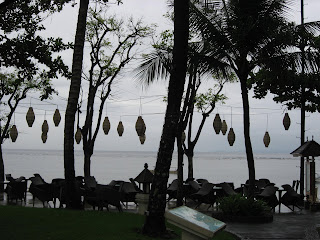 We were welcomed into our hotel with sounds of exotic musical instruments and two Balinese girls doing traditional dance moves in bright costumes at the entrance. Magnolia trees all around were in full bloom. Our magical vacation on Bali had begun!
We were welcomed into our hotel with sounds of exotic musical instruments and two Balinese girls doing traditional dance moves in bright costumes at the entrance. Magnolia trees all around were in full bloom. Our magical vacation on Bali had begun!
Both magical and mythical, this land of volcanic lakes, spectacular rice terraces, stunning tropical beaches, ancient temples and palaces is an exotic melting pot of cultures and peoples. Renowned for its architecture, traditional theatre, dance and elaborate religious festivals, the colorful Balinese culture is constantly synthesizing the old and the new, the traditional and the innovative.
 There has been considerable effort put into making this a prime tourist destination. All the high-end hotels have a presence here and more seem to be coming in every year. The airport has a nice ambience, friendly staff, and a good collection of duty-free and food outlets. I noticed that the roads are better than in most Indian cities. All this goes a long way in making your vacation experience one to remember.
There has been considerable effort put into making this a prime tourist destination. All the high-end hotels have a presence here and more seem to be coming in every year. The airport has a nice ambience, friendly staff, and a good collection of duty-free and food outlets. I noticed that the roads are better than in most Indian cities. All this goes a long way in making your vacation experience one to remember.
There are temples everywhere. However, they are quite different from the Hindu temples in India. The temples are almost always black in color and have a distinct architecture. The idols and sculptures of the gods (Garuda, Ganesha, Vishnu) look different from the ones in India; some have very fierce expressions and look warrior-like. Visitors have to cover their legs before entering a temple; most temples will provide a sarong and sash for this purpose. However, you can wear your shoes inside (unlike Indian temples).
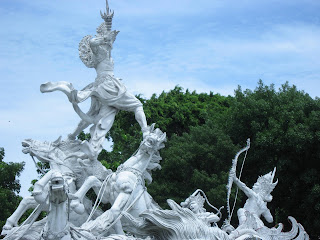 Balinese dances are inspiried by the Ramayana and the Mahabharata. We watched a Kecak dance performance at the Uluwatu temple in an open amphitheater. This temple is perched on a steep cliff 70 meters above the crashing waves of the oceans; the locals refer to this place as the Sunset Temple because of the spectacular views of the sunset from this location. Visitors beware of the monkeys here; they will snatch anything shiny or interesting in your hands or on your body including your glasses (I saw one unfortunate Japanese tourist being relieved of his glasses). Some locals will offer to get stolen stuff back from the monkeys for a tip! I am certain they train these monkeys to steal stuff :)
Balinese dances are inspiried by the Ramayana and the Mahabharata. We watched a Kecak dance performance at the Uluwatu temple in an open amphitheater. This temple is perched on a steep cliff 70 meters above the crashing waves of the oceans; the locals refer to this place as the Sunset Temple because of the spectacular views of the sunset from this location. Visitors beware of the monkeys here; they will snatch anything shiny or interesting in your hands or on your body including your glasses (I saw one unfortunate Japanese tourist being relieved of his glasses). Some locals will offer to get stolen stuff back from the monkeys for a tip! I am certain they train these monkeys to steal stuff :)
 We also visited Kuta, the place where all the nightspots are located; this is a good place to shop, eat out and walk around. We bought some handicrafts and souvenirs here. I was intrigued by the figurines of Garuda, which is also the mascot and name of the Indonesian airline. For more info on the mythology of Garuda, go here.
We also visited Kuta, the place where all the nightspots are located; this is a good place to shop, eat out and walk around. We bought some handicrafts and souvenirs here. I was intrigued by the figurines of Garuda, which is also the mascot and name of the Indonesian airline. For more info on the mythology of Garuda, go here.
There are places we could not visit: The 'mother temple' at Besakih, the active volcano at Batur Caldera, and the hot springs near Lovina on the northern coast. But even with the brief time we spent at Bali, we carry back lovely memories of this Island of the Gods!
Some tips for new travellers: Keep US $10 per pax in cash ready if you intend to get a visa on arrival. Also, keep local currency worth 10, 000 rupiah(approx US $10) per pax for exit tax which has to be paid after checking and before boarding.
Other Bali posts from this trip: Ringing in the New Year at Bali, Indonesia, Gourmet in Bali, The Laguna Spa & Resort
Read More...
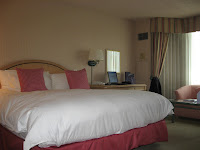 This was the first time I have stayed at one of Sofitel's hotel. Distinctively European, the hotel has a very airy and spacious feel to it. The feeling continues as you enter the room; the pastel shades, floral curtains, and European styled furnishings are a pleasant change.
This was the first time I have stayed at one of Sofitel's hotel. Distinctively European, the hotel has a very airy and spacious feel to it. The feeling continues as you enter the room; the pastel shades, floral curtains, and European styled furnishings are a pleasant change. I found the breakfast here particularly good; the breads, croissants and pancakes were very fresh and better than those I find in most other hotels. Also the seafood pasta I ordered for lunch after checking-in was good too.
I found the breakfast here particularly good; the breads, croissants and pancakes were very fresh and better than those I find in most other hotels. Also the seafood pasta I ordered for lunch after checking-in was good too. Finally, I went out with some friends to the Straits restaurant yesterday which features Singaporean food; while the food was good, the highlight was the excellent mango mousse we had for desserts. Today, we had lunch in a Thai place called Erawan; the Thai fried calamari and Spicy Basil Fried Rice were pretty good. I also discovered Thai style iced coffee in which they use coconut milk to give it that unique taste.
Finally, I went out with some friends to the Straits restaurant yesterday which features Singaporean food; while the food was good, the highlight was the excellent mango mousse we had for desserts. Today, we had lunch in a Thai place called Erawan; the Thai fried calamari and Spicy Basil Fried Rice were pretty good. I also discovered Thai style iced coffee in which they use coconut milk to give it that unique taste. I catch my Lufthansa flight tomorrow to begin my journey back to Pune, this time over the Atlantic.
I catch my Lufthansa flight tomorrow to begin my journey back to Pune, this time over the Atlantic.





